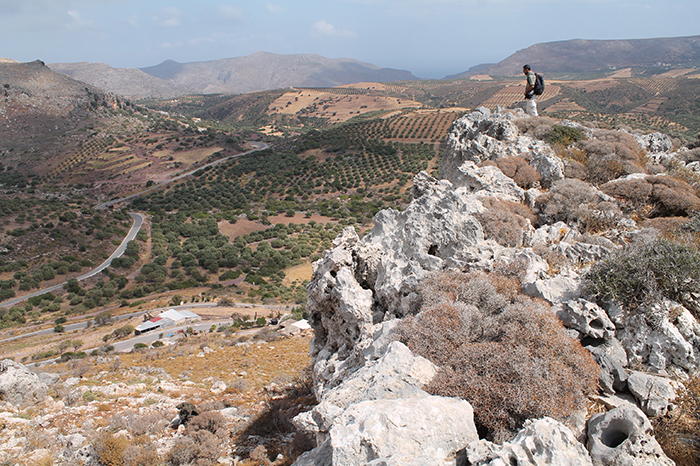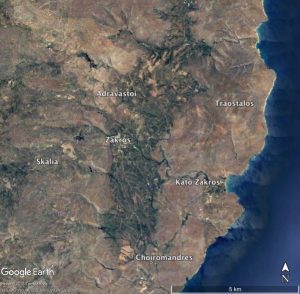Study Regions – Zakros Valley – Cetina Valley
The Zakros Valley is a fertile region on the east coast of Crete, an island in the Mediterranean Sea. The area is well known for its extensive archaeological remains, which mostly date to the Minoan period (the third to second millennia BC). At that time, settlement was concentrated in the palatial center at Kato Zakros, an outpost at Choiromandres, Minoan “mansions” scattered throughout the valley, and a settlement at Palaiokastron (modern Rousolako) to the north. Other well-known Minoan sites include peak sanctuaries, such as the one at Traostalos. The region also has ancient remains dating to the Classical to early Byzantine periods (5th century BC to 6th century AD). Important sites include the 4th-century BC temple of Samonian Athena and the ancient city of Itanos, both north of the Zakros Valley, and a settlement at modern Xerokampos to the south.
Less is known about the region after the medieval period. The island of Crete became a Venetian territory in 1204 AD, and in 1669 the entire island was conquered by the Ottoman Empire. The abandoned village at Skalia dates to this period, as do villages like Zakros and Adravastoi that are still inhabited. Crete was a valuable asset to the Ottomans and Venetians because of its strategic location guarding the Aegean Sea, but while the island as a whole was well integrated into these imperial domains, the area around the Zakros Valley was far removed from the main cities. As with other “internal frontiers” within imperial territories, the region acted as a frontier of state power within the island itself. In 1898, Crete became independent from the Ottoman Empire, and in 1908 it was unified with the modern Greek state.

View of the Zakros Valley from above Adravastoi
Further reading
Davies, S., and J.L. Davis. 2007. “Greeks, Venice, and the Ottoman Empire.” In Between Venice and Istanbul: Colonial Landscapes in Early Modern Greece, edited by S. Davies and J.L. Davis, 25-31. Princeton: American School of Classical Studies at Athens.
Kolovos, Elias. 2010. Η Επαρχία Της Σητείας Στα Πρώτα Χρόνια Της Οθωμανικής Κυριαρχίας: Προκαταρκτικές Παρατηρήσεις Με Βάση Τις Οθωμανικές Φορολογικές Απογραφές [The Province of Sitia in the Early Years of Ottoman Domination: Preliminary Observations Based on Ottoman Tax Registers]. In Πεπραγμένα Ι΄ Διεθνούς Κρητολογικού Συνεδρίου (Χανιά, 1-8 Οκτωβρίου 2006), Τόμος Β1: Βυζαντινή και Μεταβυζαντινή περίοδος (Ιστορία), pp. 451-72. Chania: Φιλολογικός Σύλλογος «ο Χρυσόστομος».
Spanakis, Stergios G. 1991. Πόλεις και χωριά της Κρήτης στο πέρασμα των αιώνων (Μητρώον των οικισμών) [Cities and Villages of Crete over the Centuries (Registry of Settlements)], 2 vols. Heraklio: Γ. Δετοράκης.
Stallsmith, Allaire B. 2007. “One Colony, Two Mother Cities: Cretan Agriculture under Venetian and Ottoman Rule.” In Between Venice and Istanbul: Colonial Landscapes in Early Modern Greece, edited by S. Davies and J.L. Davis, 151-171. Princeton: American School of Classical Studies at Athens.
.
